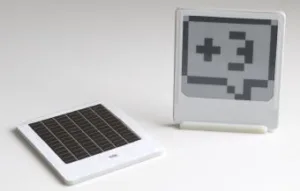A team of researchers within the Sensors and Devices Group at Microsoft Research (Cambridge, UK) and headed by postdoctoral researcher Tobias Große-Puppendahl are developing an electronic version of a Post-it note.
The prototype note device is solar powered and contains a low resolution (132 pixel) bistable E-ink display. Since the display is e-paper, it requires very little power and looks similar to paper. The device can be updated over Bluetooth Low-Energy by a phone, tablet or other such device.
The back of each note is a flexible solar panel which serves to collect energy from ambient light. Current usage and applications of the note are limited by the fact that the rear of the device cannot be covered due to the solar panel. Looking towards the future, the team commented that recent developments in transparent photo voltaic cells may allow collecting energy from the front of the note using invisible light.
A recent publication focused on the electronic note was presented by the team at the User Interface Software and Technology (UIST)’16 conference held between October 16th and 19th in Tokyo, Japan. It can be found on-line here.
The article includes evaluations of the prototype that demonstrated it was possible to do one update operation (consisting of downloading new content and refreshing the display) every one minute when illuminated by daylight or every 25 minutes when illuminated by indoor lighting. To put these times into proper context, the team commented that, when the device is used as a Post-it note, there is little reason for frequent updates.
A video found at the end of this article illustrates how the electronic note device is assembled and how it operates.
A particularly important aspect of the team’s investigation was into the trade-off between power consumption and the number of pixels in the display. Indeed, one of the conclusions drawn by the team in their article is that a low resolution (but large pixel) e-paper display can achieve a high number of updates using a limited energy budget.
The article includes speculation that configuring and managing multiple note devices could be cumbersome and/or error prone. This is due to the fact that the display in the note reacts too slowly for interactive setup. One proposed solution to this problem is to use augmented reality to present an interactive overlay via a mobile device like a smartphone or tablet. In fact, the high contrast, blocky, low-resolution images produced by the e-paper display suggests that the note device may be particularly suited for use as part of augmented reality system.
The team has provided details of the note device’s hardware design to enable other researchers to replicate and build upon their work. -Arthur Berman
Microsoft Research, Tobias Große-Puppendahl, +44-7583-170940, [email protected]

